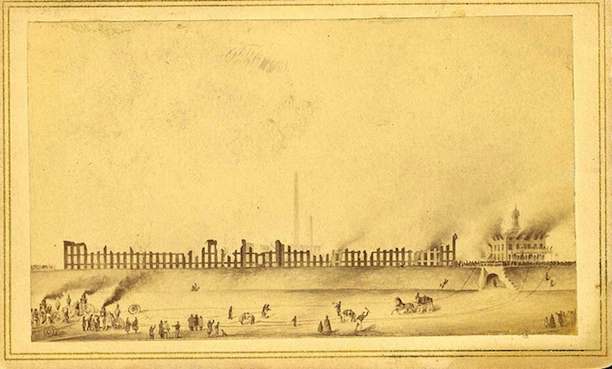Samuel Colt, the man who revolutionized firearms manufacturing in the United States, was born in Hartford, Connecticut, on July 19, 1814. The son of a textile worker, Colt got himself expelled from Amherst Academy as a young man, so his father sent him on a year-long sailing voyage to study navigation. While aboard ship, Colt became enamored with the spinning and locking mechanisms used by the ship’s wheel and carved a wooden model of a revolver that used a similar mechanism for loading and firing ammunition.
Upon returning from sea, Samuel Colt filed a patent for his design and, after receiving funding from his family, opened the Patent Arms Company in Paterson, New Jersey. The company originally produced three revolving handguns (one made for a belt, one for a holster, and one to fit in a pocket) and two rifles, but Colt failed to obtain any government contracts and the business struggled. The company’s shareholders eventually took it over and relegated Colt to the role of sales agent before finally shutting down operations and selling off the company assets in 1842.
A Reinvigorated Business
In 1845, reports from the West praising Colt’s revolvers began reaching Washington. The revolver allowed soldiers fighting on the plains to fire six shots in rapid succession without reloading. Prior to using Colt’s revolver, reloading between shots took approximately 20 seconds. The army soon ordered 1,000 weapons for use in the war begun with Mexico. Colt revived his revolving arms business and his manufacturing system of interchangeable parts allowed him to deliver all the requested firearms by 1847.
With his business now a success, Colt looked to expand his operations. In 1851 he became the first American manufacturer to open a plant in England. He also began purchasing property along the banks of the Connecticut River in Hartford as a location on which to build a new factory. He bought the land for a very low price (because of its susceptibility to flooding) and built a two-mile-long dike to protect his operations from the river.

Samuel Colt’s London factory on the banks of the Thames River, London, 1853 – Connecticut State Library,State Archives, PG 460, Colt Patent Fire Arms Manufacturing Company
The new factory—the largest privately owned manufacturing plant in the world—opened in 1855 under the company’s new name, the Colt Patent Fire-Arms Manufacturing Company. Colt installed the distinctive onion dome on top of his plant to draw extra attention to his business.
Colt sold his products through a variety of different outlets. He employed a small force of traveling salesman and also utilized jobbers who acted as wholesale agents capable of selling product to retailers in large quantities. In addition, Colt accepted orders directly from rich and powerful customers looking for customized pieces. He marketed his product through ad campaigns focused on romantic displays of Western heroism, and also by designing rich ornamental pieces for display at international fairs. It was a strategy that proved very successful.
Elizabeth Colt Takes Charge
By the time of his death in 1862, Colt was one of the richest men in the country. He produced over 400,000 firearms in his lifetime and made his brand the most widely known in existence. His wife, Elizabeth, took over a large portion of his estate (worth approximately $15 million) along with his business. She led it through one of the most challenging times in the company’s history.
On February 4, 1864, approximately an hour after beginning their workday, workers noticed fire and smoke rising from the attic of the Colt factory. A steam gong alarm sounded and workers rushed to the attic with a hose, but no water came out. The fire rapidly spread throughout the entire facility, burning it to the ground. Authorities never determined a cause for the blaze, though unconfirmed rumors of Confederate arsonists became a popular explanation among local residents.

A lithograph carte de visite of the Colt’s armory fire of 1864 by R.S. De Lamater, Hartford – Connecticut State Library, State Archives, PG 460, Colt Patent Fire Arms Manufacturing Company
Faced with $2 million in damages and a facility that lay in ruins, Elizabeth Colt had a decision to make—to take on the daunting task of rebuilding on-site or to relocate the company to a more pristine or fully operational location. Although her husband did not feel the need to insure his buildings, Elizabeth Colt did, and she luckily took out insurance on the Colt manufacturing buildings shortly after Samuel’s death. She used that insurance money to rebuild the factory on its existing site in Hartford.
The success that followed the rebirth of the company only bolstered the Colt legacy. In 1872, Colt began manufacturing its first breech-loading revolver for use with a self-contained metallic cartridge. This single-action revolver became the world famous “Peacemaker,” and earned the title of “The Gun That Won the West.”
In 1901, shortly before the death of Elizabeth Colt, the Colt family sold their firearms business. Maintaining the Colt name, the new company continues to produce some of the most famous and reliable firearms (such as the Colt .45) in American history. The area in and around the factory complex rebuilt by Elizabeth Colt received a listing on the National Register of Historic Places in June of 1976 and remains a popular and memorable part of the Hartford landscape today.










